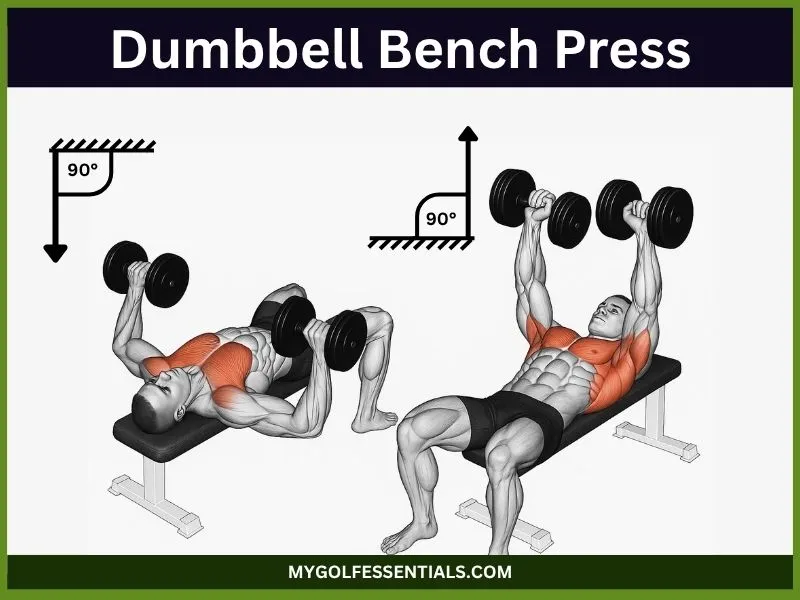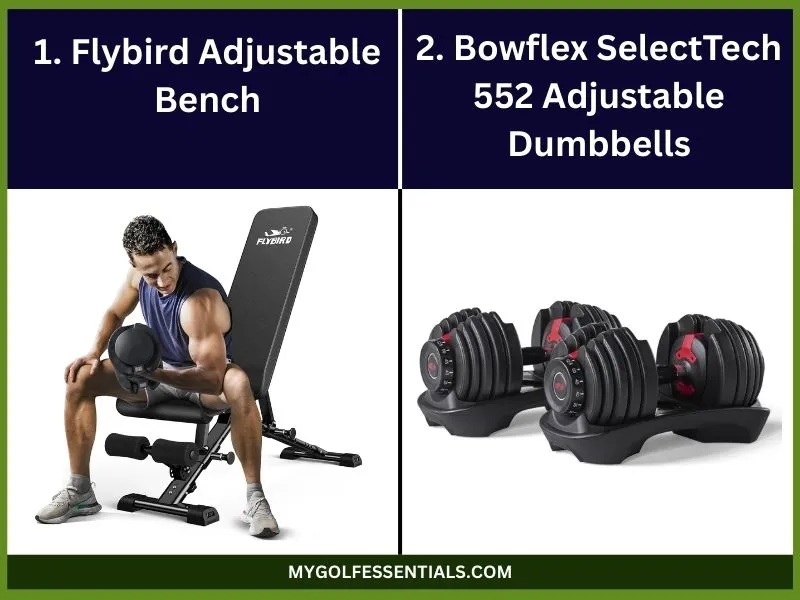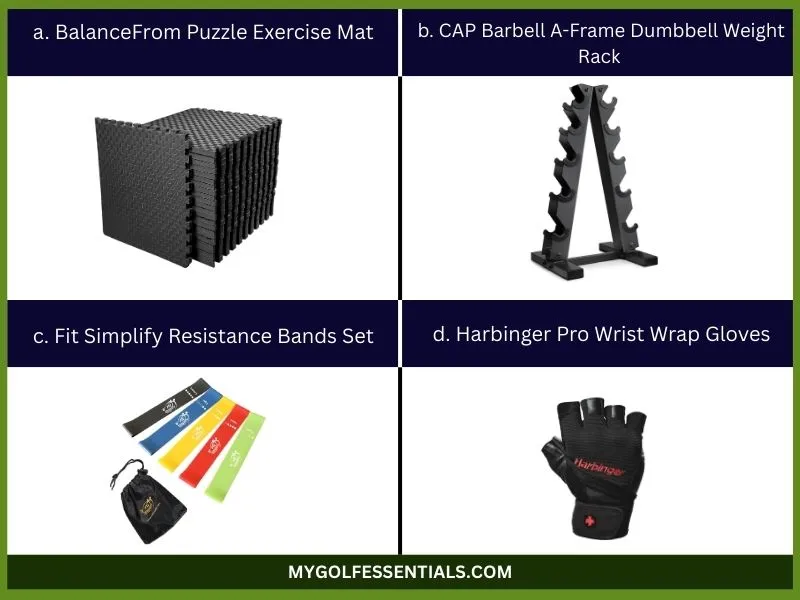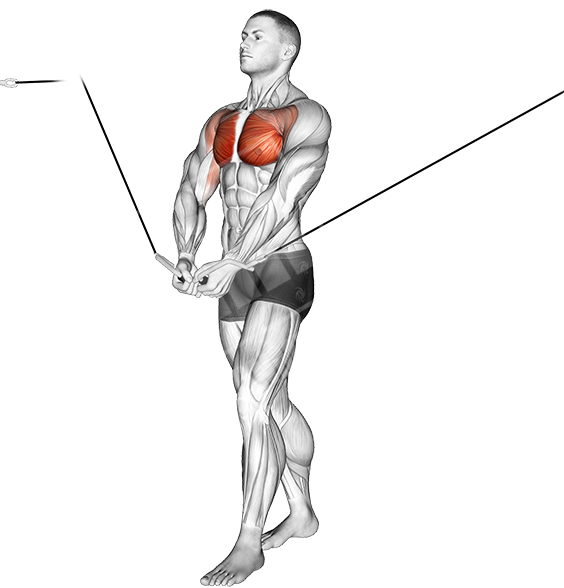
Looking to build a stronger chest, improve upper body strength, or fine-tune your lifting technique? The dumbbell bench press is one of the most effective exercises for targeting your chest, shoulders, and triceps, all while enhancing stability and control.
In this article, we’ll break down everything you need to know about the dumbbell bench press in 2025, from proper form and key benefits to expert tips and common mistakes. Read on to make sure you’re getting the most out of every rep.
What is the Dumbbell Bench Press?
The dumbbell bench press is a popular strength training exercise that targets the upper body, specifically the chest, shoulders, and arms. It involves lying flat on a bench and pressing a pair of dumbbells upward in a controlled motion, then lowering them back down to chest level.
Unlike the traditional barbell bench press, using dumbbells allows each arm to move independently. This not only improves muscular balance but also challenges your body’s stabilizer muscles, especially around the shoulders and core. The increased range of motion also makes the exercise more versatile and effective for full chest development.
Purpose of the Exercise
The main goal of the dumbbell bench press is to:
- Build muscle mass and strength in the upper body.
- Improve muscle coordination and control.
- Enhance shoulder stability and joint health.
- Address muscle imbalances that may be overlooked in barbell movements.
- Support overall performance in sports and other compound exercises.
Main Muscles Targeted
The dumbbell bench press works several key muscles:
- Chest (Pectoralis Major): It is the primary muscle involved in pressing the weights up.
- Shoulders (Anterior Deltoids): Assist in lifting and stabilizing the dumbbells.
- Triceps (Triceps Brachii): Help extend the elbows during the push.
- Stabilizer Muscles: Smaller supporting muscles, especially in the shoulders and core, work to keep the dumbbells balanced throughout the movement.
This makes the dumbbell bench press not only a go-to chest-building move but also a functional exercise for improving overall upper body strength and control.
Benefits of the Dumbbell Bench Press
The dumbbell bench press is a solid choice for anyone looking to build upper body strength and muscle. It not only helps develop key muscle groups but also supports better control, joint stability, and safer training.
Here are the main benefits:
- Builds Muscle and Increases Strength: Pushing heavy dumbbells targets the chest, shoulders, and triceps, which helps increase muscle growth and overall upper body strength over time.
- Improves Muscle Balance and Symmetry: Since each arm works independently, the dumbbell bench press can correct strength imbalances between the left and right sides. This leads to more balanced muscle development.
- Offers a Greater Range of Motion: Compared to the barbell bench press, dumbbells allow for a deeper stretch at the bottom of the movement and a fuller contraction at the top. This extended range of motion helps activate more muscle fibers.
- Enhances Joint Stability and Reduces Injury Risk: The freedom of movement with dumbbells allows your shoulders and wrists to move in a more natural path. This helps reduce stress on joints and lowers the chance of injury, especially during long-term training.
- Versatile Training Angles: Dumbbells can be used on flat, incline, or decline benches, which makes it easy to target different parts of the chest. This variety also keeps workouts more dynamic and effective.
- Safer to Perform Without a Spotter: With no bar locked over your body, you can safely drop dumbbells to the side if you fail a rep. This makes the dumbbell bench press a safer option for solo workouts.
All in all, the dumbbell bench press is a fantastic exercise that provides strength, control, and flexibility. Plus, it helps reduce the risk of injuries while giving you a balanced and full-range chest workout!
How to Do the Dumbbell Bench Press: Step-by-Step Guide For 2025
The dumbbell bench press is a fundamental exercise for building upper body strength. To perform it effectively and safely, it’s essential to have the right equipment and follow proper form.
Equipment Needed
- Bench: A sturdy, adjustable bench that can be set to flat, incline, or decline positions.
- Dumbbells: A pair of dumbbells with a weight suitable for your fitness level.
Our Recommendation

| Product | Why It’s Best | |
| 1. Flybird Adjustable Bench | Over 25,000+ positive reviews, 7 backrest settings, foldable, and perfect for home setups | Check It Out on Amazon |
| 2. Bowflex SelectTech 552 Adjustable Dumbbells | Replaces 15 sets of weights, easy dial system, compact design, highly rated | Check It Out on Amazon |
Additional Equipment (Not Compulsory, but Helpful)
If you’re serious about home training or want more variety and comfort, consider these optional upgrades:
- Rubber Flooring or Exercise Mat: Protects your floor and provides better grip and cushioning.
- Dumbbell Rack: Keeps your weights organized and makes it easier to switch between different loads.
- Resistance Bands: Can be added for extra resistance or assistance depending on your workout.
- Wrist Wraps or Lifting Gloves: Useful if you experience wrist discomfort or need a better grip during pressing movements.
Our Recommendations

| Product Name | Why It’s Good | |
| a. BalanceFrom Puzzle Exercise Mat | Protects floors, easy to clean, and provides grip for your bench setup | Check Out on Amazon |
| b. CAP Barbell A-Frame Dumbbell Weight Rack | Keeps your space organized and makes switching weights easier | Check Out on Amazon |
| c. Fit Simplify Resistance Bands Set | Great for warm-ups, assistance, or added resistance; compact and versatile | Check Out on Amazon |
| d. Harbinger Pro Wrist Wrap Gloves | Offers wrist support, improves grip, and protects hands during pressing | Check Out on Amazon |
With just the essentials mentioned above, you’re ready to train your upper chest at home. The optional gear can improve your experience, but it’s not required to start seeing results.
How To Set Up Your Body, Bench Position, Grip, and Dumbbell Placement
- Bench Position: Set the bench to a flat position. Ensure it’s stable and on a non-slip surface.
- Body Position: Lie back on the bench with your head, shoulders, and buttocks in contact with the bench. Feet should be flat on the floor.
- Grip: Hold a dumbbell in each hand with a neutral grip (palms facing forward).
- Dumbbell Placement: Start with the dumbbells at chest level, elbows bent at approximately 90 degrees.
Step-by-Step Instructions for Proper Form
- Starting Position: Lie on the bench with dumbbells held at chest level, elbows bent.
- Press: Push the dumbbells upward until your arms are fully extended, but not locked.
- Pause: Hold the dumbbells at the top for a brief moment.
- Lower: Slowly lower the dumbbells back to the starting position, maintaining control.
- Repeat: Perform the desired number of repetitions.
Key Form Tips
- Feet Placement: Keep your feet flat on the floor to maintain stability.
- Shoulder Position: Retract your shoulder blades to protect your shoulders.
- Core Engagement: Tighten your core muscles to support your lower back.
Common Mistakes to Avoid
- Flaring Elbows: Keep elbows at a 45-degree angle to prevent shoulder strain.
- Arching Back: Maintain a natural spine position to avoid excessive arching.
- Using Excessive Weight: Choose a weight that allows you to maintain proper form.
- Inconsistent Range of Motion: Lower the dumbbells to chest level for full engagement.
By adhering to these guidelines, you can effectively incorporate the dumbbell bench press into your workout routine, promoting muscle growth and strength while minimizing the risk of injury.
What Are The Variations Available For Dumbbell Bench Press?
The dumbbell bench press has several variations that allow you to target different areas of the chest and upper body. Adjusting the bench angle, grip position, or using one arm at a time can change the focus of the exercise and help improve muscle balance, strength, and overall development.
Here are the main variations:
1. Flat Dumbbell Bench Press
- This is the standard version of the exercise.
- Targets the middle portion of the chest, with strong involvement from the shoulders and triceps.
- Great for overall chest development and strength.
2. Incline Dumbbell Bench Press
- Performed on a bench set to a 30–45 degree incline.
- Emphasizes the upper chest (clavicular head of the pectorals) and front deltoids.
- Helpful for creating a fuller chest appearance and improving shoulder strength.
3. Decline Dumbbell Bench Press
- Done on a decline bench with the head lower than the hips.
- Focuses more on the lower chest muscles.
- Can reduce shoulder strain and provide a unique angle that’s often undertrained.
4. Neutral Grip and Other Grip Variations
- Neutral Grip (palms facing each other): Reduces shoulder stress and activates more of the triceps.
- Reverse Grip (palms facing toward your face): Shifts focus to the upper chest and biceps.
- Grip variations are useful for adjusting emphasis and managing shoulder discomfort.
5. Single-Arm (Unilateral) Dumbbell Bench Press
- Involves pressing with one dumbbell at a time.
- Improves core engagement and balance, as your body must resist rotating.
- Useful for correcting muscle imbalances between sides.
Using different dumbbell bench press variations in your training not only keeps workouts fresh but also ensures all parts of your chest are developed evenly. This variety can help you break through strength plateaus and reduce overuse injuries by spreading the workload across different muscle fibers and angles.
What’s The Difference Between Dumbbell Bench Press vs. Barbell Bench Press?
Both dumbbell and barbell bench presses are great for building upper body strength, but they have some key differences that can affect how you train. Each has its own benefits depending on your goals, equipment access, and experience level.
1. Range of Motion Differences
- Dumbbell Bench Press allows for a wider range of motion. You can lower the dumbbells deeper and bring them closer together at the top.
- Barbell Bench Press limits your range of motion since the bar stops at chest level and your hands stay fixed in position.
Why it matters: A greater range of motion can lead to more muscle activation, especially in the chest.
2. Muscle Activation and Symmetry
- Dumbbells force each side of the body to work independently, helping improve balance and correct strength imbalances.
- Barbells engage both arms together, which can sometimes let the stronger side take over.
Why it matters: If symmetry and balance are your focus, dumbbells are often the better choice.
3. Safety and Ease of Use
- Dumbbell Presses are generally safer for solo workouts. If you fail a rep, you can drop the weights to the side.
- Barbell Presses can be riskier without a spotter, as the bar is directly above your chest and harder to bail from.
Why it matters: Beginners or home lifters may prefer dumbbells for peace of mind when training alone.
4. When to Choose Each Variation
| Choose Dumbbells If: | Choose Barbell If: |
| You want a greater range of motion | You want to lift heavier weights overall |
| You’re training to fix muscle imbalances | You’re aiming to increase maximum strength |
| You don’t have a spotter or train alone often | You have access to a bench rack and safety bars |
| You want more control over joint positioning | You’re focused on progressive overload in powerlifting |
In short, both lifts can be part of a strong training routine. Dumbbells give you freedom, balance, and range. Barbells give you structure, heavier loads, and power. Use both wisely based on your training goals.
How To Program a Dumbbell Bench Press Session
Programming your dumbbell bench press workouts properly can help you reach your fitness goals efficiently. Whether you want to build strength, muscle size, or endurance, adjusting sets, reps, and progression is key.
Recommended Sets and Reps for Different Goals
| Goal | Sets | Reps per Set | Rest Between Sets |
| Strength | 3–5 | 3–6 | 2–3 minutes |
| Hypertrophy (Muscle Growth) | 3–4 | 8–12 | 60–90 seconds |
| Endurance | 2–3 | 12–20 | 30–60 seconds |
- For strength, focus on heavier weights with fewer reps.
- For hypertrophy, use moderate weights with moderate reps.
- For endurance, lighter weights and higher reps improve muscle stamina.
How to Progress
To keep making gains, you need to challenge your muscles over time. Here are ways to progress:
- Increase Weight: Add small increments of weight when you can complete your sets and reps comfortably.
- Increase Reps: Add extra reps within your target range before increasing the weight.
- Change Variations: Switch between flat, incline, or decline dumbbell bench press to hit muscles differently and avoid plateaus.
- Adjust Tempo: Slow down the lowering phase (eccentric) for more muscle tension.
How to Include Dumbbell Bench Press in Your Workout Routine
- Upper Body Day: Include dumbbell bench press as a main pressing movement alongside rows and shoulder exercises.
- Push/Pull Split: Use it on push days paired with overhead press and triceps work.
- Full Body Workout: Add it as one of your pressing exercises, balancing it with pulling and leg work.
- Frequency: 1–3 times per week depending on your training level and recovery.
A well-structured dumbbell bench press session fits smoothly into most training plans and helps you build a balanced, strong upper body over time.
Tips for Better Results
Getting the most out of your dumbbell bench press means focusing on technique, muscle engagement, and preparation. Here are some simple tips to help you maximize your gains safely and effectively.
1. Maximize Chest Activation
- Focus on Squeezing Your Chest: As you press the dumbbells up, imagine bringing them together to engage the chest muscles fully.
- Control the Movement: Avoid using momentum. Lower the dumbbells slowly and push up with steady, controlled force.
- Keep Elbows at a 45-Degree Angle: This helps put more stress on the chest and less on the shoulders.
2. Adjust Grip and Wrist Angle
- Neutral Grip (Palms Facing Each Other): Places less strain on the shoulders and activates the triceps more.
- Standard Grip (Palms Facing Forward): Targets the chest muscles primarily.
- Slight Wrist Angle Adjustments: Small changes in wrist rotation can shift tension between the chest, shoulders, and triceps. Experiment to find what feels best.
3. Use the Mind-Muscle Connection and Tempo
- Mind-Muscle Connection: Concentrate mentally on the chest muscles working during each rep. This focus can improve muscle recruitment and growth.
- Tempo: Try slowing down the lowering phase (eccentric) to 2–3 seconds and pressing up explosively. This increases time under tension for better results.
4. Warm-Up and Mobility
- Warm-Up Sets: Start with lighter weights to prepare your muscles and joints for heavier loads.
- Shoulder and Wrist Mobility: Incorporate stretches and mobility drills before training to reduce injury risk and improve range of motion.
- Proper Breathing: Exhale while pressing up and inhale while lowering to maintain core stability and control.
Applying these tips consistently will help you train smarter, avoid injuries, and see better progress with your dumbbell bench press.
Who Should and Shouldn’t Do the Dumbbell Bench Press?
The dumbbell bench press is a popular exercise, but it’s not the best fit for everyone. Knowing if it suits your fitness level and any joint concerns can help you train safely and effectively.
Who Should Do the Dumbbell Bench Press
- Beginners: It’s a great exercise to build upper body strength and learn pressing movements with better control than a barbell.
- Advanced Lifters: Ideal for adding variety, correcting muscle imbalances, and increasing range of motion.
- People Wanting Balanced Muscle Development: Since each arm works independently, it helps improve muscle symmetry.
- Those Training Without a Spotter: Dumbbells are safer to use alone because you can drop them if needed.
Who Should Be Cautious or Avoid
- People with Wrist or Elbow Issues: The dumbbell bench press requires wrist stability and can put strain on these joints if you have pre-existing pain or injuries.
- Shoulder Problems: If you experience shoulder pain during pressing motions, consult a professional before continuing.
- Beginners with Poor Form: Without proper guidance, it’s easy to develop bad habits that can lead to injury.
Alternative Options If You Have Joint Pain
- Push-Ups: A natural pressing movement with less joint stress and easy to modify.
- Machine Chest Press: Offers controlled movement and support, reducing strain on joints.
- Resistance Bands Chest Press: Low impact and adjustable resistance, good for rehab and warm-ups.
- Floor Dumbbell Press: Limits range of motion to protect shoulders while still working the chest.
If you have joint pain or injuries, it’s important to listen to your body and choose exercises that allow you to train safely. Consulting a physical therapist or fitness professional can provide personalized advice.
How Much Weight Should I Use?
Choosing the right weight for your dumbbell bench press is important to ensure you challenge your muscles without risking injury. The ideal weight depends on your experience, goals, and current strength level.
Guidelines for Choosing Weight
- For Beginners: Start light to focus on learning proper form. Use a weight you can lift comfortably for 10–12 reps without losing control. This might be anywhere from 5 to 15 pounds per dumbbell depending on your strength.
- For Muscle Growth (Hypertrophy): Use a weight that allows you to complete 8–12 reps per set with good form. The last 2 reps should feel challenging but doable without compromising technique.
- For Strength: Choose heavier dumbbells that let you perform 3–6 reps per set. You should struggle by the final rep but still maintain control.
- For Endurance: Use lighter weights that allow 12–20 reps per set to build muscular stamina.
How to Know If Your Weight Is Right
- You can complete your target reps without swinging or losing control.
- Your muscles feel fatigued by the last few reps but you can maintain proper form.
- You’re not holding your breath or compensating with other muscles to lift the weight.
Progression Tip
Start with lighter weights and gradually increase as you get stronger. If you can easily do more than your target reps, it’s time to increase the weight by small increments.
Choosing the right weight helps you train effectively and avoid injury, so always prioritize form over lifting heavy.
How often should I do the dumbbell bench press?
How often you include the dumbbell bench press in your workout depends on your training goals, overall program, and recovery ability.
General Recommendations
- For Beginners: 1–2 times per week is enough to build strength and get comfortable with the movement.
- For Muscle Growth (Hypertrophy): 2–3 times per week works well to stimulate muscle growth while allowing time for recovery.
- For Strength Training: 2 times per week is ideal to balance intense lifting with rest and avoid overtraining.
- For Maintenance or Endurance: 1–2 times per week can maintain muscle tone and endurance without excess fatigue.
Recovery Considerations
- Make sure to give your muscles at least 48 hours of rest before working the same muscle group again.
- Pay attention to how your body feels. If you notice excessive soreness or fatigue, allow extra recovery time.
- Incorporate rest days and lighter workout days in your routine.
How to Include Dumbbell Bench Press in Your Routine
- On Upper Body Days, include it alongside other pressing and pulling exercises.
- In a Push/Pull/Legs Split, perform dumbbell bench press on push days.
- If doing Full Body Workouts, limit to 1-2 sessions per week to avoid overuse.
Consistency and proper recovery are key to getting the best results from your dumbbell bench press sessions.
Can I do this exercise at home?
Yes, the dumbbell bench press can be done at home, making it a convenient option for anyone without access to a gym.
What You Need to Get Started
a. A Pair of Dumbbells: Adjustable dumbbells are ideal if you want to progress over time without buying multiple sets.
b. A Workout Bench (Optional but Recommended): A flat or adjustable bench gives you more range of motion and allows you to do flat, incline, or decline presses.
c. No Bench? Try This:
- Use a sturdy floor surface for a floor press version.
- Stack firm cushions or use a low, stable platform for added elevation (only if it’s safe).
Things to Keep in Mind
- Check Your Space: Make sure you have enough room to safely press the dumbbells without hitting anything.
- Protect the Floor: Use a mat or towel under your dumbbells to protect your floor from damage if dropped.
- Keep It Safe: Start light, especially if you’re training alone, and increase weight slowly over time.
Doing the dumbbell bench press at home is simple with basic equipment and can still be highly effective for building strength and muscle.
What if I don’t have a bench?
Don’t worry if you do not have a bench. You can still do a version of the dumbbell bench press without sacrificing results. While a bench adds range and versatility, there are effective alternatives you can use at home.
Try Doing Dumbbell Floor Press
The floor press is the best substitute if you don’t have a bench.
How to Do It:
- Lie flat on your back on the floor.
- Bend your knees with feet flat on the ground.
- Hold a dumbbell in each hand, elbows resting lightly on the floor.
- Press the dumbbells up and lower them back down until your upper arms lightly touch the ground.
Why It’s Good:
- Safer for shoulders due to reduced range of motion.
- Great for beginners or those recovering from shoulder strain.
- Builds strength in the chest and triceps.
Other Substitutes
- Use a Stability Ball: Lie on a large stability ball to mimic a bench. It activates your core but may not be ideal for heavy weights.
- Stacked Cushions or Step Platforms: Only use if they are firm and stable. Safety comes first.
- Incline Push-Ups or Resistance Band Presses: If you don’t have dumbbells or space, these can help work similar muscles.
Bottom line: You don’t need a bench to build strength. With the floor press and smart adjustments, you can still make solid progress right from your home setup.
Final Thoughts
The dumbbell bench press remains one of the most versatile and effective exercises for building a strong, balanced upper body in 2025. Whether your goal is muscle growth, improved stability, or correcting imbalances, this exercise delivers across the board. Its greater range of motion, safer solo execution, and adaptability through various angles and grip positions make it ideal for lifters of all levels.
By incorporating proper form, progressive overload, and smart programming, you can make steady gains while minimizing the risk of injury. Whether you’re training at home or in the gym, the dumbbell bench press is a smart and sustainable choice for building a stronger, more functional chest and upper body.
Key Takeaways
- Dumbbell Bench Press Targets Key Upper Body Muscles: The dumbbell bench press works the chest, shoulders, triceps, and stabilizer muscles, making it ideal for balanced upper body development.
- Doing This Exercise Improves Muscle Balance and Symmetry: Each arm works independently, helping correct imbalances and improving coordination between sides.
- Allows Greater Range of Motion: Dumbbells enable a deeper stretch and fuller contraction, activating more muscle fibers than a barbell press.
- Enhances Joint Stability and Reduces Injury Risk: The freedom of movement supports joint health and makes the exercise safer, especially for the shoulders.
- Versatile and Adaptable: Can be performed flat, incline, or decline, and with different grip variations to target different parts of the chest.
- Safer for Solo Workouts: Unlike a barbell, dumbbells can be dropped to the side if needed, reducing the risk of getting stuck under the weight.
- Builds Functional Strength: Engages core and stabilizers more than machines or barbells, translating to better performance in daily movements and sports.
- Supports a Variety of Goals: Whether you’re training for strength, hypertrophy, or endurance, it’s easy to adjust sets, reps, and weight.
- Complements Other Pressing Movements: Works well in a program with barbell presses, push-ups, and overhead presses for complete chest training.
- Beginner-Friendly Yet Effective for Advanced Lifters: Simple to learn and scalable with weight and variations, it’s useful for all fitness levels.
FAQs
Can beginners do dumbbell bench press?
Yes, beginners can perform the dumbbell bench press, but should focus on mastering proper form before increasing weight.
Is dumbbell bench press better than barbell bench press?
Both have their benefits. Dumbbells improve stabilization and can reduce the risk of shoulder injuries, while barbells allow for heavier lifting. The best choice depends on your goals and experience.



